The Huawei MateBook X Pro Review: Calling Out The Competition
by Brett Howse on June 27, 2018 8:00 AM ESTDisplay Performance
Huawei has outfitted the MateBook X Pro with a 3000 x 2000 resolution IPS display featuring low-temperature polycrystalline silicon to provide better power consumption. The 3:2 aspect ratio matches what Microsoft started offering, along with the same resolution as offered in the Surface Book 13.5, but this is a 13.9-inch display so it’s a bit larger, but still offers a solid 260 pixels per inch. Huawei has stated the display covers 100% of the sRGB gamut, and offers 1500:1 contrast along with 450 nits brightness, so we’ll see how well they do there.
The move to 3:2 is something all notebooks should look into, because for most use cases, the extra vertical resolution is very beneficial when doing almost any task, with the exception of TV and movies, which are 16:9 or wider. The aspect ratio is a great compromise between widescreen and the older 4:3 though.
So without further ado, let’s dig into the display performance. We measure displays at 200 nits brightness using SpectraCal’s CalMAN suite with a custom workflow. Contrast and brightness measurements are done with an X-Rite i1DisplayPro colorimeter, and color accuracy is tested with an X-Rite i1Pro2 spectrophotometer.
Brightness and Contrast
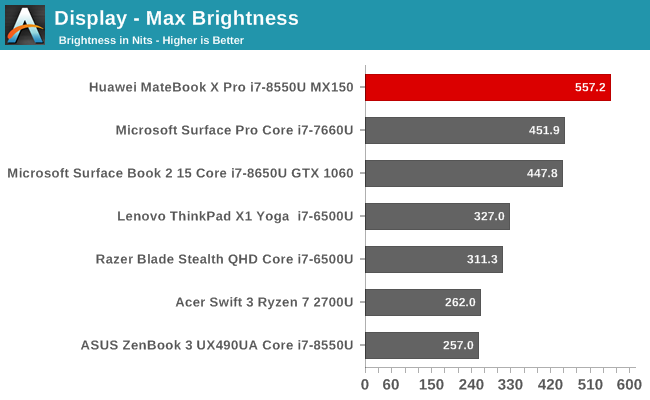
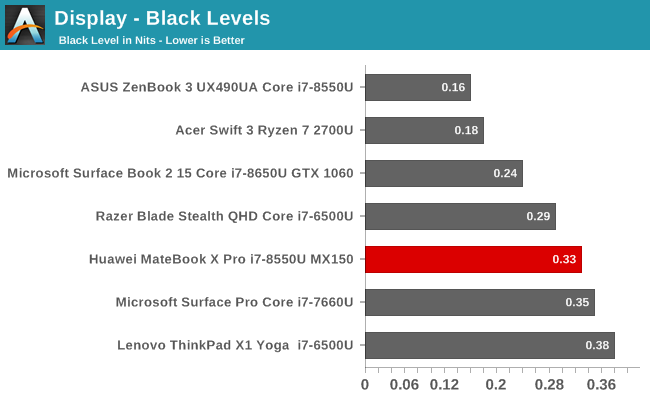
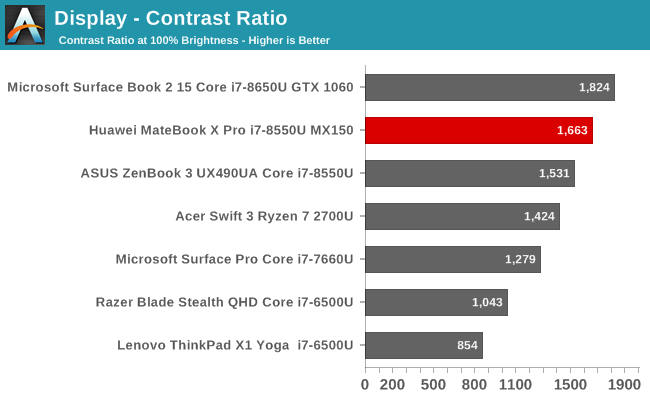
Huawei has certainly delivered on some of their claims. The MateBook X Pro review unit achieved an eye-searing 557 nits maximum brightness, but at the same time offered great black levels, with contrast well over their 1500:1 target. Every device is going to be somewhat different, but it’s great to see this unit well over their goals. With such a high brightness, the MateBook X Pro should be fairly usable outdoors as well.
Grayscale
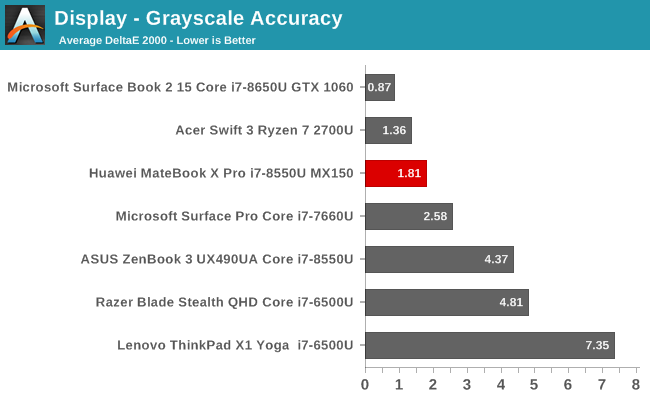
Huawei has done a very solid job at the factory with this display, with a grayscale average error level of only 1.8, and with no tested points even going over an error level of 2.5. The primary colors are also pretty solid, with blue being a bit too high but only slightly. By default the gamma is a bit too low as well coming in at an average of 2.05, with a big drop near 100% brightness. Still, it’s a very good start.
Gamut
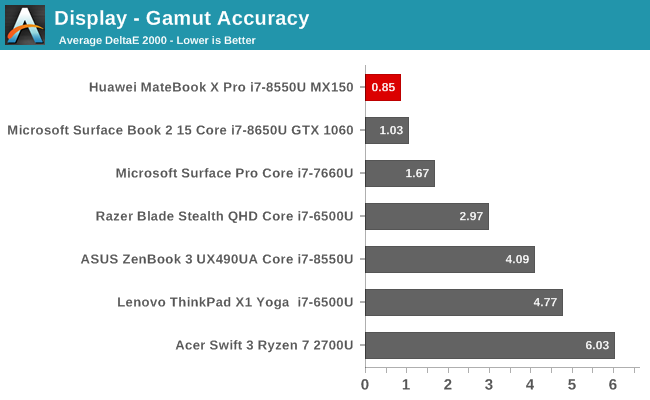
Once again this display performs very well, covering almost the entire sRGB gamut with igh levels of accuracy. The blue is only slightly under where it should be at 100%, but the overall dE2000 is a mere 0.85 which is fantastic.
Saturation
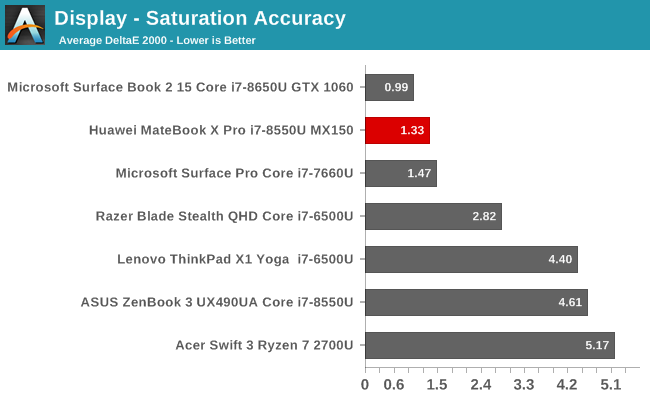
Whereas the Gamut test only does the 100% levels for the primary and secondary colors, the saturation sweep tests the entire range in 4-bit steps to make sure there’s not deviation anywhere on the range, and the MateBook X performs admirably here as well, with one of the best error levels we’ve seen.
Gretag Macbeth
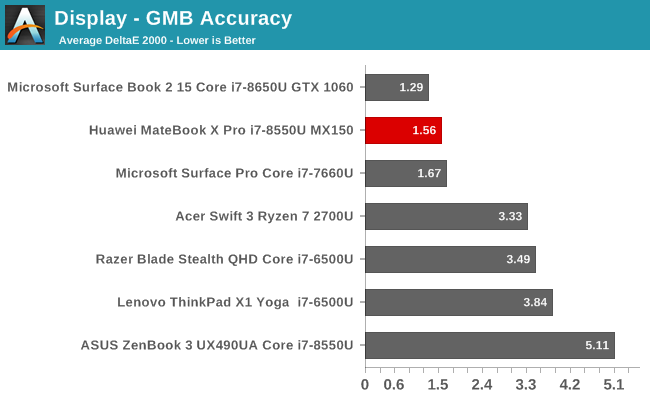
This final test moves off of just testing the primary and secondary colors, and tests important colors such as skin tones. Once again the MateBook X Pro provides a great result, with none of the individual colors even having an error level over 3.0, with almost all of them well under the 2.0 level.
Colorchecker
Here’s a sample image of the relative color errors on this display, with the bottom half of the image showing the target color, and the top half of the image showing the display output. Please note this is a relative test though because any errors in your own display will vary both the target and output.
The MateBook X Pro offers almost perfect color accuracy, and clearly Huawei has taken the extra time and cost to color calibrate the displays at the factory. For most people, the level of error is small enough that you’d never notice it unless you were doing color critical work.
Display Conclusion
What’s not to like about the MateBook X Pro’s display? It’s a high resolution display with a great aspect ratio for working. It offers incredible brightness, great contrast, and Huawei has color calibrated it to the sRGB gamut almost perfectly. There’s not much else to say other than this is a fantastic display.















77 Comments
View All Comments
MrSpadge - Wednesday, June 27, 2018 - link
I really like the meaningful and fairly priced separation between the i5 and i7 model - keep it simple and the upgrade noticeable to the user.SirCanealot - Wednesday, June 27, 2018 - link
Actually, I was thinking the same thing! For the sake of $300 I can upgrade almost everything on the system. For $300 to do that, it's quite a 'may as well' situation! :)DiscoDJ - Wednesday, June 27, 2018 - link
I know the internet is international in scope, but I do find it interesting that this article doesn't even mention the security issues the U.S. Govt. (whatever you may think of it, right now) has with Huawei or ZTE. Is there an article on this site somewhere that dismisses these concerns as unfounded?RedKiwi - Wednesday, June 27, 2018 - link
Reading through the summary of the House intelligence report on Huawei and ZTE, it seems more of a "not worth the risk" type of situation. Investigating hardware provided by Huawei and ZTE was out of the scope of the investigation. The House only questioned their involvement with the Chinese government. Both companies were unable to provide a satisfactory answer to the committee. By not allowing Huawei and ZTE to sell telecommunications equipment to US carriers, it removes the possibility of snooping even if there is no risk in the first place.I do believe consumer hardware Huawei makes is safe for general use. It might not be worth it for the government to risk.
On a side note, I wish some of these decisions would be made in other parts of the US government such as environmental laws.
vanilla_gorilla - Wednesday, June 27, 2018 - link
That's one of the most reasonable replies to that question I've seen.But we can't ignore the fact that in 2017 ZTE plead guilty to illegaly exporting US technology to Iran and North Korea.
Let me say that again: Iran and North Korea. In violation of international trade sanctions.
Then when the US called them on it, they agreed to reprimand employees and pay a fine. Instead, they only fired 4 officials and provided bonuses to 35 others. That's why the US Department of Commercen banned companies from buy ZTE products.
I don't think there's much more anaysis the government needs to do. Security is all based on trust and ZTE has zero. I wouldn't trust them as far as I could throw them.
ianmills - Wednesday, June 27, 2018 - link
Well the results sound about par for how the US handled their own 2009 financial crisis hahainvinciblegod - Wednesday, June 27, 2018 - link
"But we can't ignore the fact that in 2017 ZTE plead guilty to illegaly exporting US technology to Iran and North Korea. Let me say that again: Iran and North Korea. In violation of international trade sanctions."You say that like it's a super surprising thing but you'll be surprised to learn that many companies actually make a cost benefit analysis and more often than would be expected choose to illegally export US parts to those countries. They just know that if they get caught they will pay a fine and then everything is fine. Just search "companies that violate sanctions to iran" on google and you will see how many companies do it and get caught. ZTE obviously miscalculated on how much they could get away with in the plea deal.
invinciblegod - Wednesday, June 27, 2018 - link
Also, ZTE is not Huawei.Samus - Thursday, June 28, 2018 - link
LOL I was about to say the same thing.Oxford Guy - Tuesday, July 3, 2018 - link
Yep. If the benefit (the profit) outweighs the slap on the wrist (the cost) then why wouldn't any corporation go for it? Corporations are not people. They're financial mechanisms designed to enrich some people. They just happen to have real people to do some of that work (along with AI, robotics, etc.).